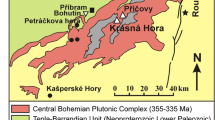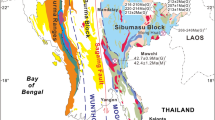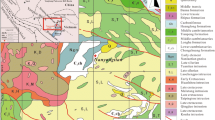Abstract
The Ixtahuacan Sb-W deposits are hosted by upper Pennsylvanian to Permian metasedimentary rocks of the central Cordillera of Guatemala. The deposits consist of gold-bearing arsenopyrite, stibnite and scheelite. Arsenopyrite and scheelite are early in the paragenesis, occurring as disseminations in pyritiferous black shale/sandstone and in argillaceous limestone, respectively. Some stibnite is disseminated, but the bulk of the stibnite occurs as massive stratabound lenses in black shales and in quartz-ankerite veins and breccias, locally containing scheelite.
Microthermometric measurements on fluid inclusions in quartz and scheelite point to a low temperature (160–190°C) and low to moderate salinity (5–15 wt% NaCl eq.) aqueous ore fluid. Abundant vapour-rich inclusions suggest that the fluid boiled. Carbon dioxide was produced locally as a result of interaction of the aqueous fluid with the argillaceous limestone. Bulk leaching experiments and SEM-EDS analyses of decrepitated fluid inclusion residues indicate that the ore-bearing solution was NaCl-dominated. The δ18O values of quartz, ankerite and scheelite from mineralized veins range from 19.7 to 20.5‰, 18.1 to 20.0‰ and 7.0 to 8.4‰ respectively. The average temperature calculated from quartz-scheelite oxygen isotopic fractionation is 170°C. The oxygen isotopic composition of the fluid, interpreted to have been in equilibrium with these minerals, ranged from 5.7 to 7.6‰, and is considered to represent an evolved meteoric water. Diagenetic or syngenetic pyrite has a sulphur isotopic composition of 0.5±0.3‰ which is consistent with bacterial reduction of sulphate. The δ34S values of arsenopyrite and stibnite range from −2.8 to 2.0‰ and −2.7 to −2.3‰ respectively, and are though to reflect sulphur derived from pyrite.
The Ixtahuacan deposits are interpreted to have formed at low temperature (<200°C) and a depth of a few hundred metres from a low fO2 (10−49−10−57), high pH (7–8) fluid. Arsenic was probably transported as arsenious acid, antimony and gold as thio-complexes and tungsten as the complex HWO −4 .
A model is proposed in which a meteoric fluid, heated by a felsic intrusion at depth, was focused to shallow levels along faults. The interaction of the fluid with pyritiferous beds caused the deposition of arsenopyrite as a result of sulphidation and/or decreasing fO2; gold probably co-precipitated with As or was adsorbed onto the arsenopyrite. The precipitation of stibnite was caused by boiling. Scheelite deposited in response to the increase in Ca2+ activity which accompanied interaction of the ore fluid with the argillaceous limestones.
Similar content being viewed by others
References
Aral, H. (1989) Antimony mineralization in the northern Murat Dagi (Western Turkey). Econ. Geol. 84:780–787
Ault, W.V., Jensen, M.L. (1963) Summary of sulfur isotope standards. In: Jensen, M.L., (ed.) Biogeochemistry of sulfur isotopes. Nat. Sci. Found. Symposium Proc., Yale University, pp. 16–29
Ballantyne, J.M., Moore, J.N. (1988) Arsenic geochemistry in geothermal systems. Geochim. Cosmochim. Acta 52:475–483
Barin, L, Knacke, O., Kubaschewski, O. (1977) Thermochemical properties of inorganic substances. Springer, Berlin Heidelberg New York, 861 p.
Belhaj, O., Moine, B., Munoz, M., Fortune, J.P. (1991) Conditions of the formation of the Sb deposit of Boujaada (Morocco). In: Pagel, M., Leroy, J. (eds) Source, transport and deposit of metals. Balkema, Rotterdam, pp. 161–164
Bodnar, R.J. (1983) A method of calculating fluid inclusions volumes based on vapour bubble diameters and P-V-T-X properties of inclusion fluids. Econ. Geol.. 78:535–542
Bottrell, S.H., Yardley, B., Buckley, F. (1988) A modified crushleach method for the analysis of fluid inclusion electrolytes. Bull. Minéral. 111:279–290
Bozzo, A.T., Chen, J.R., Barduhn, A.J. (1973) The properties of hydrates of chlorine and carbon dioxide. In: Delyannis, A., Delyannis, E. (eds.) Fourth International Symposium on Fresh Water from the Sea 3:437–451
Brown, P.E., Lamb, WM. (1989) P-V-T properties of fluids in the system H2O-CO2-NaCl: new graphical presentation and implications for fluid inclusion studies. Geochim. Cosmochim. Acta 53:1209–1221
Burruss, R.C. (1981) Analysis of phase equilibra in C-O-H-S fluid inclusions. Mineral. Assoc. Can Short Course Handbook 6:39–74
Cathelineau, M., Boiron, M.-C., Holliger, P., Marion, P., Denis, M. (1989) Gold in arsenopyrites: crystal chemistry, location and state, physical and chemical conditions of deposition. Econ. Geol. 84:328–341
Clayton, R.N., O'Neil, J.R., Mayeda, T.K. (1972) Oxygen isotope exchange between quartz and water. J. Geophys. Res. 77:3057–3067
Claypool, G.E., Holser, W.T., Kaplan, I.R., Sakai, H., Zak, I. (1980) The age curves of sulfur and oxygen isotopes in marine sulfate and their mutual interpretation. Chem. Geology 28:199–260
Collins, E.M., Kesler, S.E. (1969) Short notes. High temperature telescoped tungsten-antimony mineralization, Guatemala. Mineral. Deposita 4:65–71
Craig, H. (1961) Isotopic variations in meteoric waters. Science 133:1702–1703
Crawford, M.L. (1981) Phase equilibria in aqueous fluid inclusions. Mineral. Assoc. Can Short Course Handbook 6:75–100
Fournier, R.O., Truesdell, A.H. (1973) An empirical Na-K-Ca geothermometer for natural waters. Geochim. Cosmochim. Acta 37:1255–1275
Guillemette, N. (1991) Geology and geochemistry of the Ixtahuacan Sb-W deposits, northwestern Guatemala. Unpublished MSc thesis, McGill University, Montréal, 108 p.
Haynes, F.M., Kesler, S.E. (1987) Chemical evolution of brines during Mississippi Valley-Type mineralization: evidence from east Tennessee and Pine Point. Econ. Geol. 82:53–71
Haynes, F.M., Sterner, S.M., Bodnar, R.J. (1988) Synthetic fluid inclusions in natural quartz. IV. Chemical analyses of fluid inclusions by SEM/EDA: evaluation of method. Geochim. Cosmochim. Acta 52:969–977
Heinrich, C.A., Eadington, P.J. (1986) Thermodynamic predictions of the hydrothermal chemistry of arsenic, and their significance for the paragenetic sequence of some cassiterite-arsenopyritebase metal sulfide deposits. Econ. Geol. 81:511–529
Hyland, M.M., Bancroft, G.M. (1989) An XPS study of gold deposition at low temperatures on sulphide minerals: reducing agents. Geochim. Cosmochim. Acta 53:367–372
Krupp, R.E., Seward, T.M. (1987) The Rotokawa geothermal system, New Zealand: an active epithermal gold-depositing environment. Econ. Geol. 82:1109–1129
Krupp, R.E. (1988) Solubility of stibnite in hydrogen sulfide solutions, speciation, and equilibrium constants, from 25° to 350 °C. Geochim. Cosmochim. Acta 52:3005–3015
Krupp, R.E. (1990a) Comment on As(III) and Sb(III) sulfide complexes: an evaluation of stoichiometry and stability from existing experimental data by NF Spycher and MH Reed. Geochim. Cosmochim. Acta 54:3239–3240
Krupp, R.E. (1990b) Response to reply by NF Spycher and MH Reed. Geochim. Cosmochim. Acta 54:3245
Madu, B.E., Nesbitt, B.E., Muehlenbachs, K. (1990) A mesothermal gold-stibnite-quartz vein occurrence in the Canadian Cordillera. Econ. Geol. 85:1260–1268
Matthews, A., Katz, A. (1977) Oxygen isotope fractionation during dolomitization of calcium carbonate. Geochim. Cosmochim. Acta 41:1431–1438
Munoz, M., Shepherd, T.J. (1987) Fluid inclusion study of the Bournac polymetallic (Sb-As-Pb-Zn-Fe-Cu...) vein deposit (Montagne Noire, France). Mineral. Deposita 22:11–17
Nast, H.J, Williams-Jones, A.E. (1991) The role of water-rock interaction and fluid evolution in forming the porphyry-related Sisson Brook W-Cu-Mo deposit, New Brunswick. Econ. Geol. 86:302–317
Nesbitt, B.E., Muehlenbachs, K., Murowchick, J.B. (1989) Genetic implications of stable isotope characteristics of mesothermal Au deposits and related Sb and Hg deposits in the Canadian Cordillera. Econ. Geol. 84:1489–1506
Ohmoto, H. (1972) Systematics of sulphur and carbon isotopes in hydrothermal ore deposits. Econ. Geol. 67:551–577
Ohmoto, H., Rye, R.O. (1979) Isotopes of sulphur and carbon. In: Barnes, H.L. (ed.) Geochemistry of hydrothermal ore deposits, 2nd edn. Wiley, New York, pp. 509–567
Paterson, C.J. (1986) Controls on gold and tungsten mineralization in metamorphic hydrothermal systems, Otago, New Zealand. Geol. Assoc. Canada Spec. Paper 32:25–39
Poty, B., Stalder, H.A., Weisbrod, A. (1974) Fluid inclusion studies in quartz from fissures of Western and Central Alps. Schweizer. Mineralog. Petrog. Mitt. 54:717–752
Potter, R.W.II, Clynne, M.A., Brown, D.L. (1978) Freezing point depression of aqueous sodium chloride solutions. Econ. Geol. 73:284–285
Renders, P.J., Seward, T.M. (1989) The adsorption of thio gold (I) complexes by amorphous As2S3 and Sb2S3 at 25 and 90°C. Geochim. Cosmochim. Acta 53:255–267
Robinson, B.W., Farrand, M.G. (1982) Sulfur isotopes and the origin of stibnite mineralization in New England, Australia. Mineral. Deposita 17:161–174
Roedder, E. (1958) Technique for the extraction and partial chemical analysis of fluid-filled inclusions from minerals. Econ. Geol. 53:235–269
Roedder, E. (1984) Fluid inclusions. Mineral. Soc. of America, Reviews in Mineralogy 12:644 p.
Scott, S.D., Barnes, H.L. (1971) Sphalerite geothermometry and geobarometry. Econ. Geol. 6:653–669
Scratch, R.B., Watson, G.P., Kerrich, R., Hutchinson, R.W. (1984) Fracture-controlled antimony-quartz mineralization, Lake George deposit, New Brunswick: mineralogy, geochemistry, alteration and hydrothermal regimes. Econ. Geol 79:1159–1186
Seward, T.M. (1973) Thio complexes of gold and the transport of gold in hydrothermal ore solutions. Geochim. Cosmochim. Acta 37:379–399
Siesser, W.G. (1967) Stratigraphy and plutonic rocks of the Cuilco quadrangle, Guatemala. MSc thesis, Louisiana State University, 87 p.
Spycher, N.F., Reed, M.H. (1989) As(III) and Sb(III) sulfide complexes: an evaluation of stoichiometry and stability from existing experimental data. Geochim. Cosmochim. Acta 53:2185–2194
Spycher, N.F., Reed, M.H. (1990a) Reply to comments by RE Krupp on As(III) and Sb(III) complexes: an evaluation of stoichiometry and stability from existing experimental data. Geochim. Cosmochim. Acta 54:3241–3244
Spycher, N.F., Reed, M.H. (1990b) Response to response of RE Krupp. Geochim. Cosmochim. Acta 54:3246
Thode, H.G., Monster, J. (1965) Sulfur isotope geochemistry of petroleum, evaporites, and ancient seas. Amer. Assoc. Petroleum Geol. Mem. 4:367–377
Wesolowski, D., Drummond, S.E., Mesmer, R.E., and Ohmoto, H. (1984) Hydrolysis equilibrium of tungsten (IV) in aqueous sodium chloride solutions to 300°C. Inorg. Chem. 23:1120–1132
Wesolowski, D., Ohmoto, H (1986) Calculated oxygen isotope fractination factors between water and the minerals scheelite and powellite. Econ. Geol. 81:471–477
Weyl, R. (1980) Geology of Central America. Borntraeger, Berlin, 371 p.
Werre, R.W. Jr., Bodnar, R.J., Bethke, P.M., Barton, P.B. Jr. (1979) A novel gas-flow fluid inclusion heating/freezing stage (abstr.). Geol. Soc. Am. Abstr. Programs 11: 539
Wood, S.A., Crerar, D.A., Borcsik, M.P. (1987) Solubility of the assemblage pyrite-pyrrhotite-magnetite-sphalerite-galena-gold -stibnite-bismuthinite-argentite-molybdenite in H2O-NaCl-CO2 solutions from 200 to 350°C. Econ. Geol. 82:1864–1887
Wood, S.A., Vlassopoulos, D. (1989) Experimental determinations of the hydrothermal solubility and speciation of tungsten at 500°C and 1 kbar. Geochim. Cosmochim. Acta 53:303–312
Author information
Authors and Affiliations
Rights and permissions
About this article
Cite this article
Guillemette, N., Williams-Jones, A.E. Genesis of the Sb-W-Au deposits at Ixtahuacan, Guatemala: evidence from fluid inclusions and stable isotopes. Mineral. Deposita 28, 167–180 (1993). https://doi.org/10.1007/BF00204040
Received:
Accepted:
Issue Date:
DOI: https://doi.org/10.1007/BF00204040




